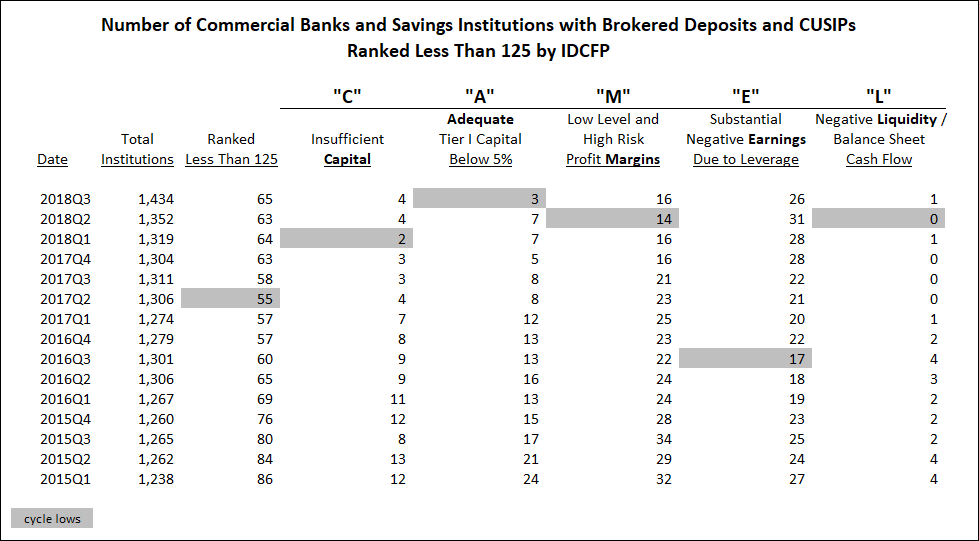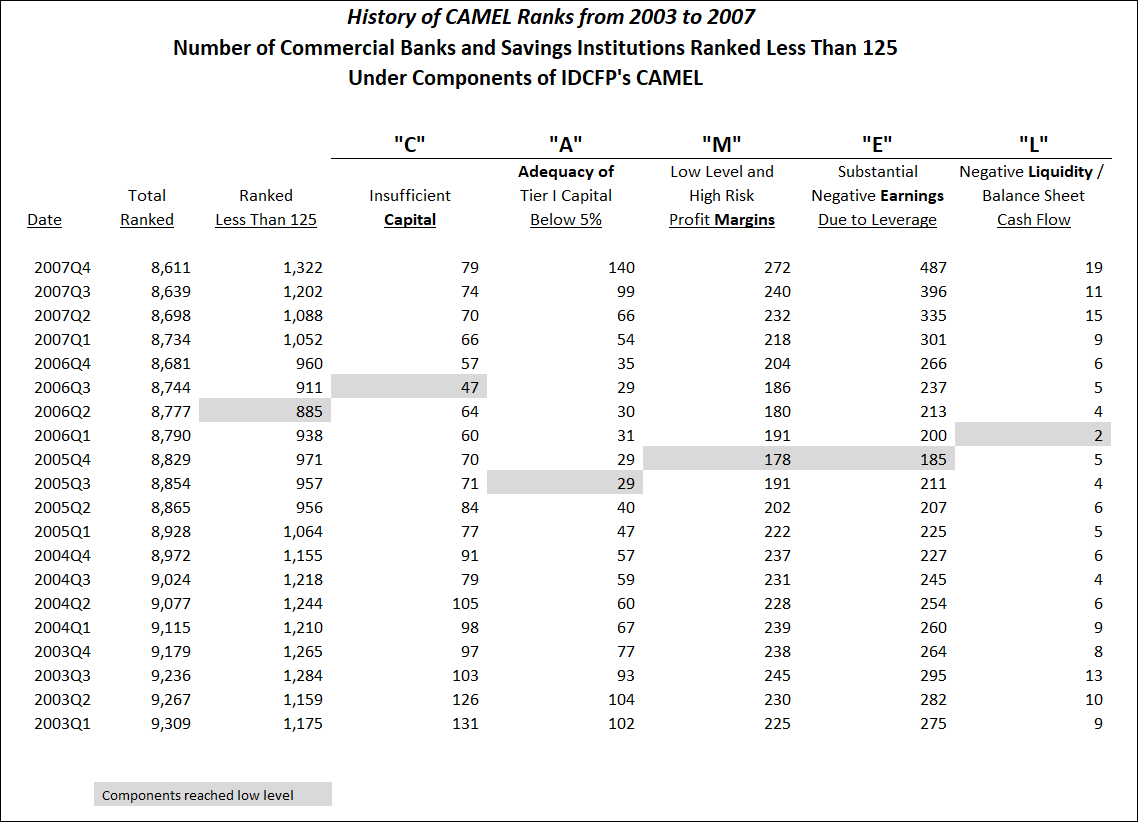IDC Financial Publishing’s CAMEL Safety Ratings Explained - The “C” in CAMEL: Capital Requirements in Banks
IDC Financial Publishing, Inc. (IDCFP) uses the acronym CAMEL to represent the financial ratios we use to evaluate the safety and soundness of commercial banks and savings institutions. This article explains how we use the capital requirements ratios in banks as a component of its CAMEL ranking, and why it is valuable to monitor.
Capital ratio requirements used by the FDIC to determine if an institution is well-capitalized are:
- Tier 1 Leverage Capital Ratio (Tier 1 capital divided by Tier 1 assets) of 5% or higher.
- Total Risk Based Capital Ratio (Tier 1 + Tier 2 capital divided by risk-based assets) of 10% or higher
- Tier 1 Risk Based Capital Ratio (Tier 1 capital divided by risk-based assets) of 6% or higher
At IDCFP, we also review enforcement actions by the FDIC to determine if an institution is required to file a written “Capital Plan” to increase capital above the threshold of ratios indicated above. As an example, a letter of consent for an institution might require a Tier 1 leverage ratio of 9% vs. the standard 5%. IDCFP then uses the 9% threshold as the Tier 1 requirement until the enforcement action is terminated.
Our CAMEL rating system of banks, savings institutions, and credit unions range from 300 (the top grade attainable) to 1 (the lowest). From the early 1990’s, through today, institutions using our safety ranks determined that ratings lower than 125 were deemed below investment grade. Commercial banks and savings institutions with capital ratios below the requirements outlined above have “insufficient capital” and, therefore, receive an IDCFP rank below 125.
A Forecast for the Next Banking Crisis
Out of the 5,525 total commercial banks and savings institutions, we have identified 1,434 that have outstanding brokered CDs. Using this group of 1,434 institutions, and tracking institutions ranked less than 125 within this group, we have put together a forecast indicating the next era of banking problems is due in 2021.
Table I illustrates the trend of most CAMEL components reaching lows when examining commercial banks and savings institutions ranked less than 125 by IDCFP (see Table I).
- The number of risky institutions reached a low of 55 in the second quarter of 2017.
- The “C” component, or institutions with insufficient Capital, fell to a low of 2 in the first quarter of 2018.
- The “A” component represents institutions lacking Adequacy of capital to cover delinquency with less than 5% risk-adjusted capital. These institutions declined to a new low of 3 in the third quarter of 2018.
- The “M” component, which uses Margins as a measure of management reached a low level of 14 in the second quarter of 2018.
- The “E” component represents institutions exhibiting negative Earnings or returns on financial leverage (ROFL). These institutions fell to a low of 17 as early as the third quarter of 2016.
- Finally, the “L” component, which represents Liquidity, or negative balance sheet cash flow, fell to 0 in the second quarter of 2018.
When examining institutions with outstanding brokered CDs, there is an increase in the number among these that we ranked less than 125. The current trend shows the number of these institutions in most components of CAMEL have hit a low and are rising (see Table I). This group of institutions ranked less than 125, and having brokered CDs, points to another potential banking problem in 2021. Similarly, in 2005 and 2006, the IDCFP CAMEL ranks that fell under 125 forecast the 2008 and 2009 banking crisis. (See Table II).
Table I

Early Warning Indicators in History
The number of commercial banks and savings institutions ranked below 125 reached a low in the 2nd quarter of 2006, two years before the banking crisis in 2008. More importantly, leading up to this point, 4 out of the 5 components of CAMEL also reached lows from the 3rd quarter of 2005 through the 1st quarter of 2006, and then began to rise.
As seen in Table II below,
- Commercial banks and savings institutions with insufficient capital reached a low of 47 institutions in the 3rd quarter of 2006.
- Financial institutions with less than 5% adequacy of capital reached a low count of 29 in the 3rd quarter of 2005.
- Banks and savings institutions with a lack of profitability, or low and unstable margins, reached a low of 178 in the 4th quarter of 2005.
- The commercial banks and savings institutions with severe negative earnings due to financial leverage reached their low of 185 in the 4th quarter of 2005.
- Finally, institutions with high loan delinquency and negative balance sheet cash flow, or negative liquidity, reached their low of 2 in the 1st quarter of 2006.
All 5 categories of rank, Capital, Adequacy of capital, Margins as a measurement of management, Earnings from operations and financial leverage, and, finally, Liquidity, together provide a timely indication of risk and potential failure. An increase in the number of banks ranked under 125 in all components of CAMEL is required to confidently forecast a future banking crisis.
Table II

As seen in history, the increase in the number of financial institutions with an IDCFP CAMEL rating below 125, or below investment grade, forecast the bank financial crisis a few years later. Our ranks are critical for investors to monitor financial institutions.
To view our products and services please visit our website at www.idcfp.com . For further information about our CAMEL ranks, or for a copy of this article, please contact us at 800-525-5457 or info@idcfp.com.
